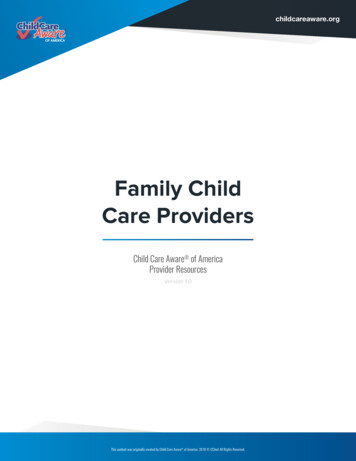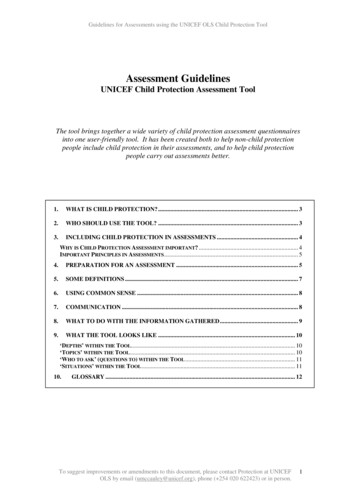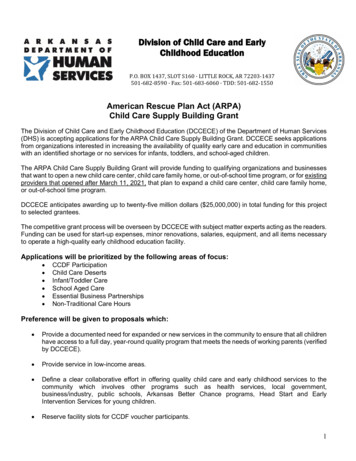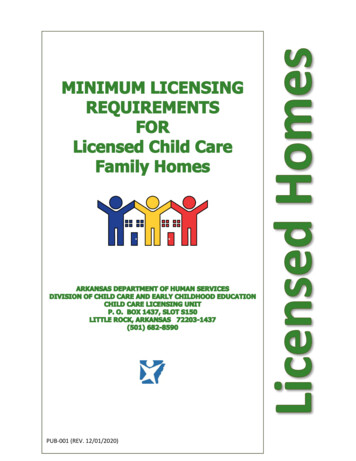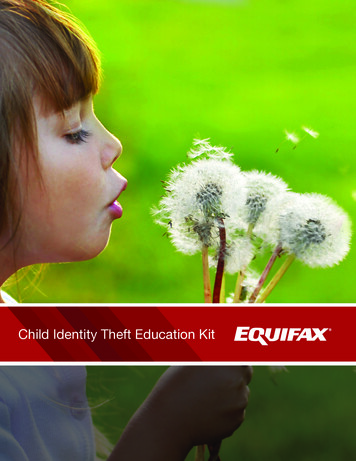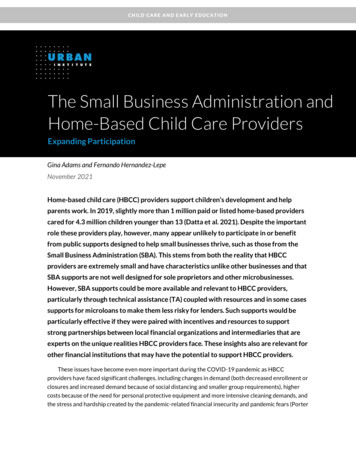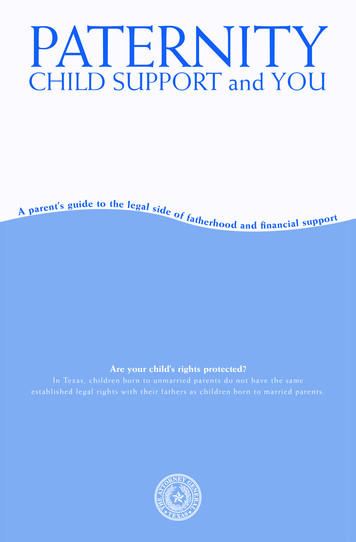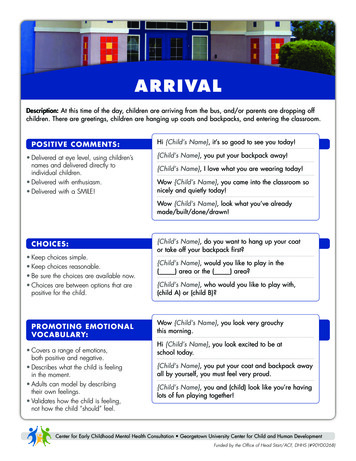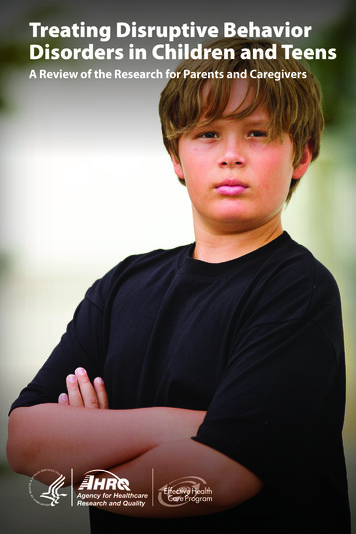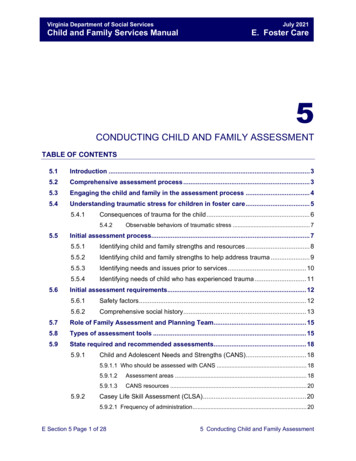
Transcription
Virginia Department of Social ServicesChild and Family Services ManualJuly 2021E. Foster Care5CONDUCTING CHILD AND FAMILY ASSESSMENTTABLE OF CONTENTS5.1Introduction . 35.2Comprehensive assessment process . 35.3Engaging the child and family in the assessment process . 45.4Understanding traumatic stress for children in foster care . 55.4.1Consequences of trauma for the child . 65.4.25.55.6Observable behaviors of traumatic stress . 7Initial assessment process. 75.5.1Identifying child and family strengths and resources . 85.5.2Identifying child and family strengths to help address trauma . 95.5.3Identifying needs and issues prior to services . 105.5.4Identifying needs of child who has experienced trauma . 11Initial assessment requirements. 125.6.1Safety factors . 125.6.2Comprehensive social history . 135.7Role of Family Assessment and Planning Team. 155.8Types of assessment tools . 155.9State required and recommended assessments. 185.9.1Child and Adolescent Needs and Strengths (CANS). 185.9.1.1 Who should be assessed with CANS . 185.9.25.9.1.2Assessment areas . 185.9.1.3CANS resources . 20Casey Life Skill Assessment (CLSA) . 205.9.2.1 Frequency of administration . 20E Section 5 Page 1 of 285 Conducting Child and Family Assessment
Virginia Department of Social ServicesChild and Family Services ManualJuly 2021E. Foster Care5.9.2.2 Assessment areas . 205.9.2.3 Resources . 215.9.3Early Periodic Screening, Diagnosis, and Treatment (EPSDT) . 215.9.3.1 When EPSDT screenings shall be conducted . 225.9.4Assessment by managed care organization . 225.9.5Best interest determination for school placement . 225.10Documenting the assessment . 235.11Additional resources. 23E Section 5 Page 2 of 285 Conducting Child and Family Assessment
Virginia Department of Social ServicesJuly 2021Child and Family Services ManualE. Foster Care5CONDUCTING CHILD AND FAMILY ASSESSMENT5.1 IntroductionA comprehensive child and family assessment is the essential foundation for sounddecision making in partnership with the child and family. Assessment involves thecontinuous process of gathering information from multiple sources over time using astrength-based approach to help evaluate, with the family, the most effective strategiesfor achieving safety, timely permanence, and well-being for their child.The process should be driven by the strengths and needs of the child and family, ratherthan the availability of services. This approach expands the diverse resources availableto support the child and family. It allows the strengths and natural supports of the child,family, and extended family, as well as the formal services of the child-serving agenciesand community, to be creatively matched with the identified needs and issues. Thisprocess lays the foundation for creatively designing strategies, services, and supportsduring service planning and service delivery to improve outcomes.5.2 Comprehensive assessment processThe assessment process begins with the family’s first contact with the child welfaresystem and continues until the case is closed.The comprehensive assessment is an ongoing process assessing the effectiveness ofservices provided to the child, birth parent or prior custodian, and foster and adoptiveparents.The effectiveness of services provided and the need for additional services shall beassessed every three (3) months if the goal is to return home and at least every six (6)months after placement for as long as the child or youth remains in foster care.During a comprehensive family assessment, the service worker should:E Section 5 Page 3 of 285 Conducting Child and Family Assessment
Virginia Department of Social ServicesChild and Family Services ManualJuly 2021E. Foster Care Engage and build relationships with the child, family, extended family, serviceproviders, and other significant people to gather information. Observe patterns of child and family interactions over time and the impact on thechild. Identify child and family strengths, protective factors, and resources that can bemobilized. Identify needs of the child and family that impact the child’s safety, permanency,and well-being. Assess other factors that may have contributed to the child’s placement in caresuch as: domestic violence; alcohol and drug abuse; mental health issues;chronic health problems; physical, intellectual, and cognitive disabilities; andpoverty. Understand the broader issues impacting the family, such as employment,adequate housing, child care, transportation, needed services, and supports. Consider how the information gathered will guide service planning, decisionmaking, and the efficient use of resources.5.3 Engaging the child and family in the assessment processAs experts on their own family, the child and family are essential sources for informationon what is impacting the safety, permanency, and well-being of the child. Involving thefamily and other significant individuals increases the effectiveness of decision making,service planning, and implementation. The service worker is more effective in gathering,analyzing, and determining the meaning of information. With better information, plansand decisions are more individualized and relevant to the family, thus increasing thelikelihood of implementation and creating opportunities for lasting change.The service worker should: Diligently seek out all extended family members as appropriate in theassessment process, including, but not limited to, the birth mother, birth father(including absent fathers), siblings, maternal and paternal family members,caretakers, and other individuals in the extended networks of the child and family(see Section 2 of this chapter). Strive to understand the family’s perspectives, which are often affected by theirlife experiences and cultural and ethnic heritage. Involve the child and family in identifying their own strengths, needs, andmotivation for changes.E Section 5 Page 4 of 285 Conducting Child and Family Assessment
Virginia Department of Social ServicesJuly 2021Child and Family Services ManualE. Foster Care Explore the “natural supports” available to the child and family through theirinterpersonal, social, and community relationships. Utilize the Family Partnership Meetings to gather assessment information (seeSection 2.9 of this chapter).5.4 Understanding traumatic stress for children in foster careApproximately 90 percent of children in foster care are exposed to trauma. Complextrauma is a common and serious concern for children in foster care. It occurs when thechild is exposed to multiple or prolonged traumatic events which are often invasive andinterpersonal in nature. It involves simultaneous or sequential occurrence of childmaltreatment, including psychological maltreatment, neglect, exposure to violence, and1physical and sexual abuse.In Virginia, children and youth in foster care often experience complex trauma, traumaticstress, multiple losses, and difficult challenges. Three out of four children in foster care are removed from their home due to childmaltreatment (neglect, physical abuse, sexual abuse, and/or abandonment). Over half are removed due to their parents’ situations (e.g., inability to cope, drugor alcohol abuse, inadequate housing).Some children: Witness family violence or the victimization of close friends; Experience the death, loss, or separation of a significant person; Witness or are a victim of criminal activity (e.g., drug dealing; prostitution); Witness school or community violence; Experience serious accidents or medical trauma (e.g., surgeries,hospitalizations); and/or Have parents who experience their own significant challenges, including mentalhealth or substance use disorders, or incarceration.1Excerpted and adapted from the Tri-Agency Letter on Trauma Informed Treatment dated July 11, 2012from the United States Department of Health and Human Services’ Administration for Children andFamilies (ACF), Centers for Medicare & Medicaid Services (CMS) and Substance Abuse and MentalHealth Services Administration (SAMHSA).E Section 5 Page 5 of 285 Conducting Child and Family Assessment
Virginia Department of Social ServicesChild and Family Services ManualJuly 2021E. Foster CareUpon entering foster care, children grieve the separation from their parents, caregivers,siblings, friends, significant other persons, and the loss of everything familiar. Thistraumatic experience is then often compounded by systemic issues in foster care thatexacerbate the child’s traumatic response through multiple changes in foster careplacements, service workers, and school placements.5.4.1 Consequences of trauma for the childIn addition to the traumatic event, the child’s experience of the event can createwide-ranging and lasting adverse effects on the child’s developmental functioningand physical, social, emotional, or spiritual well-being. The child’s response to thetrauma is significantly related to the child’s development stage. Adverse effects canimpact the child’s physiological responses; emotional responses; ability to think,learn, and concentrate; impulse control; self-image; and relationships with others. The child can become emotionally overwhelmed by the intense fear, anger,shame, and helplessness that they feel following a traumatic experience. Seemingly innocuous events such as sounds, smells, places, and othertrauma reminders may reconnect the child with the emotional states of fear,terror, and hopelessness produced by the trauma. The child’s mistaken feelings of guilt and self-blame for the negative events inhis or her life may lead to a sense of hopelessness. The child can have difficulty regulating emotions, knowing and describingfeelings and internal states, and appropriately communicating wishes anddesires to others. A child’s traumatic experiences can alter his or her worldview, sense ofsafety, and ability to interpret the meaning of the behavior of others—including people who are trying to help. The child now sees the world asuncertain, untrustworthy, and unpredictable.Sustained, chronic, or multiple exposures to trauma can impact the child’sdevelopment and the child’s ability to form attachments, to develop relationships, toself-regulate, and to learn. Traumatic events may create new or secondary problemsin the child’s life (e.g., difficulties in school, problems with substance usedisorder).These difficulties may be adaptive in the short term but have the potentialto interfere with the child’s long term recovery. The child’s development of age-appropriate self-regulation may be delayed. The child’s inability to regulate emotions may interfere with his or her ability tofunction in a family, in a traditional classroom, and with peers.E Section 5 Page 6 of 285 Conducting Child and Family Assessment
Virginia Department of Social ServicesJuly 2021Child and Family Services ManualE. Foster Care “Bad behavior” is most often the traumatized child’s attempt at self-regulation.When faced with trauma reminders, the child’s resulting behaviors may be anappropriate response to internal turmoil but may seem inappropriate in thecurrent situation. The child can isolate himself or herself from family, peers, and social andemotional support. The child’s ability and motivation to succeed in social and educational settingsmay be impaired. The child may engage in reckless, high-risk, or destructive coping behaviors.Without help and support, children often develop a variety of negative copingresponses to traumatic stress. A child’s response to traumatic stress may manifestacross multiple domains of functioning and developmental processes, includingemotional, behavioral, interpersonal, physiological, and cognitive functioning. Theseresponses may have both short- and long-term consequences for the child’s wellbeing in education, physical health, mental health, and life trajectory.Across the life span, complex trauma has been linked to a wide range of problems,including addiction, chronic physical conditions, depression and anxiety, self2harming behaviors and other psychiatric disorders.5.4.2 Observable behaviors of traumatic stressChildren manifest symptoms of traumatic stress through behaviors. Service workersand caregivers should be aware of various behaviors seen in children and youth whohave experienced trauma and/or mental health issues. See 5.11 AdditionalResources for more information.5.5 Initial assessment processA comprehensive initial assessment increases the likelihood of matching services,resources, and supports to address the critical needs and issues for the child andfamily, thus increasing the likelihood of safety, timely permanency, and well-being forthe child.2Information in this section excepted and adapted from: Tri-Agency Letter on Trauma Informed Treatment dated July 11, 2012 from the United StatesDepartment of Health and Human Services’ Administration for Children and Families (ACF),Centers for Medicare & Medicaid Services (CMS) and Substance Abuse and Mental HealthServices Administration (SAMHSA). Child Welfare Trauma Training Toolkit: Trainer’s Guide—1st Edition March 2008 The NationalChild Traumatic Stress Network. www.NCTSN.orgE Section 5 Page 7 of 285 Conducting Child and Family Assessment
Virginia Department of Social ServicesJuly 2021Child and Family Services ManualE. Foster CareIn conducting the initial assessment, the service worker should: Engage with the child, family members, and other significant individuals to:o Discuss the purpose, process, participants’ roles, and any questions andconcerns about the assessment process.o Identify language needs and any cultural and religious traditions that needto be respected and taken into account in planning and implementingservices.o Explore strengths, interests, resources, and formal and informal supports.o Identify issues and needs they feel need to be addressed. Identify the child’s trauma experiences and their impact on the child’s behavior toguide services and supports. Review previous records for existing information related to strengths, needs,services, family history, and potential supports to the family and child. Incorporate information gathered from other assessments, including any safetyand risk assessments from other programs and agencies. Talk with other service providers and key individuals from places where the childspends time, such as school, sports, work, and religious organizations. Determine whether other specialized assessments are needed. Identify strengths of child and family, including formal and informal supports. Identify immediate issues, concerns, and needs. Identify broader issues that create challenges and opportunities. Consider services that will meet immediate needs of the child and family. Begin identifying ways to address the broader needs of the child and family.5.5.1 Identifying child and family strengths and resourcesThe strengths, resources, and natural supports of the child, extended family,community, and agencies should be explored. Examples may include: Child complies with rules at grandmother’s home.E Section 5 Page 8 of 285 Conducting Child and Family Assessment
Virginia Department of Social ServicesJuly 2021Child and Family Services ManualE. Foster Care Mother can identify when child is going to explode with anger. Aunt is willing to help. Neighbor’s older child is a positive influence. An older sibling is working with a therapist on anger management. Child enjoys basketball and has strong relationship with coach. Child wants to be a car mechanic like an uncle.After the strengths are identified, creative strategies should be brainstormed andexplored on how to use these strengths to address identified needs. This approachallows the family to improve their capacity to meet their own needs. Continuing theexample above: after a safety plan is developed, the child could go to thegrandmother’s house in the afternoon to do homework since the child complies withher rules, the aunt could drive the child to her house, the completed homework couldbe celebrated by the child’s choice of playing basketball, playing with the neighbor’schild, or working on a car with his uncle; the grandmother could mentor the motheron enforcing rules.5.5.2 Identifying child and family strengths to help address traumaChildren often have a variety of strengths, protective factors, and coping strategiesthat promote positive adjustment to traumatic experiences and complex trauma.Service workers and caregivers should identify these strengths and support the childand family in further developing and using these strengths and strategies.Examples of protective or ameliorating factors that can moderate the impact oftraumatic stress include: Child’s strengths:o Easygoing temperament.o Social and emotional competence of child.o High intellectual ability.o Problem solving-skills.o Coping skills and self-regulation.o Social connections and support.o Promotion of self care.E Section 5 Page 9 of 285 Conducting Child and Family Assessment
Virginia Department of Social ServicesJuly 2021Child and Family Services ManualE. Foster Careo Sense of control. Parent and family strengths:o Secure attachment to adult figures who are present on a day to daybasis.o Stable, permanent environment.o Structure and routine.o Concrete supports available to family.o Social connections and supports available to family.o Temperament match with caregivers.5.5.3Identifying needs and issues prior to servicesThe needs of the child and family should be identified before considering service andplacement options. Rather than first identifying the service or placement type that isexpected to meet most of the child’s and family’s needs, service workers should firstidentify the immediate needs and issues for the child and family, and then identifyalternative strategies, services, and supports for addressing each one. Thisapproach allows creative brainstorming and leads to more effective and successfulstrategies for working with families.Needs are separate from services. Children do not need anger managementservices or treatment foster care. While these services may become part of thecomplement of services and strategies to address identified needs, they are notneeds. Examples of needs may include: Being safe from abuse and neglect. Living with a stable and permanent family. Managing free time after school before parent comes home. Reacting to disappointments without aggressive behavior. Doing homework to improve grades at school. Learning effective parenting skills. Increasing positive social and peer supports. Developing specific independent living skills.E Section 5 Page 10 of 285 Conducting Child and Family Assessment
Virginia Department of Social ServicesJuly 2021Child and Family Services ManualE. Foster CareDefining needs before identifying services allows more creative solutions to beexplored through mobilizing family and community strengths.5.5.4 Identifying needs of child who has experienced traumaThe traumatized child needs to: Develop a sense of physical and psychological safety in a caring, stable andpermanent family. Maximize his or her sense of internal safety. Understand his or her reactions through psycho-education. Understand that the trauma is only part of who he or she is. Reduce overwhelming emotions. Work through his or her emotions and learn to manage them effectively. Integrate the traumatic experience(s). Make new meaning of his or her trauma history and current experiences. Feel stable or organized in his thinking so he can function optimally. Reclaim age-appropriate power and make sound decisions through skillenhancement and future orientation. Communicate with those who advocate and make decisions on his behalf. Engage in positive and stable relationships.The service worker should help identify resources and strategies to assist the child’sfamily and caregivers in helping the child heal through: Regulating their emotional response to the child’s behavior. Assisting the child in regulating his emotions. Talking with the child about the trauma in appropriate ways. Providing structure and nurturing. Challenging the child in developmentally appropriate ways to increase ageappropriate skills and abilities.E Section 5 Page 11 of 285 Conducting Child and Family Assessment
Virginia Department of Social ServicesChild and Family Services Manual July 2021E. Foster CareShifting the child’s negative world and self view by giving the child positivemessages through language and behavior (e.g., communicate “It wasn’t yourfault; you’re a good child; you deserve to be taken care of by parents who willkeep you safe; your needs are important”).5.6 Initial assessment requirementsThe initial assessment is the basis for developing a foster care plan that addressesimmediate child and family needs and selecting a specific foster care permanency goal.The initial assessment shall: Incorporate information contained in the Child Protective Services SafetyAssessment and Family Risk Assessment completed when the child wasremoved from the home. Include a comprehensive social history of the child and family. Address the initial foster care goal and incorporate beginning exploration ofrelative resources and the formulation of a concurrent goal. Include a description of how the child, youth, birth parent or prior custodian, andother interested individuals were involved in the decision making process. Be entered into OASIS within 30 days of LDSS acceptance of the child forplacement, using the assessment screen (unless otherwise noted) andcompleting all the required elements of appropriate screens.5.6.1 Safety factorsThe completed Child Protective Services Safety Assessment shall be copied andpasted into the appropriate element of OASIS assessment screen. Identified safetyfactors shall be taken into consideration in transferring the child's custody orplacement to the LDSS such as: The child’s vulnerability (conditions that result in the child’s inability to protectself) including:o Whether the child is fearful of the caretaker or other householdmembers.o The child’s age.o The child’s developmental and mental health needs. Caregiver behaviors such as:E Section 5 Page 12 of 285 Conducting Child and Family Assessment
Virginia Department of Social ServicesJuly 2021Child and Family Services ManualE. Foster Careo Having caused serious harm to the child or threats to cause harm.o Previous maltreatment of a child.o Failure to protect or provide the necessary supervision to protect thechild from serious harm.o Explaining any injury inflicted on the child in such a way that isquestionable or inconsistent with the nature of the injury.o Refusing the LDSS workers access to the child.o Failure to meet the child’s need for food, clothing, shelter, and/ormedical and/or mental health care.o Providing physical living conditions are hazardous and threatening tothe child.o Substance use that is or has seriously affected their ability tosupervise, protect, or care for the child.o Behavior toward the child that is or has been violent or out-of-control.o Descriptions about or acts towards the child that are predominatelynegative.o A history of or suspected child sexual abuse.o Physical, intellectual, or mental health status that seriously affects theirability to supervise, protect, or care for the child.5.6.2 Comprehensive social historyIn addition to basing the initial assessment on the Child Protective Services SafetyAssessment, a comprehensive social history is critical for understanding thestrengths, needs, and experiences of the child entering care. A social history alsoallows the service worker to explore the full range of assets the family brings, as wellas additional needs to address that may increase the likelihood of a safe and stablereunification.A comprehensive social history including well-being information should be based onconsideration of at least the following factors Background history about the child including but not limited to:o Family relationships.E Section 5 Page 13 of 285 Conducting Child and Family Assessment
Virginia Department of Social ServicesJuly 2021Child and Family Services ManualE. Foster Careo Peer/adult social relationships including the child’s relationship toprevious caretakers or other adults with whom the child might live. Parent, child, family, and community strengths and risk factors present. Child health information. The service worker should use the healthinformation screens in OASIS to document the information below. Thisinformation should be based on all available health assessments, evaluations,and reports by qualified professionals knowledgeable of the child’s healthand/or health history. Information to be recorded includes:o Child demographics and physical description of the child.o Birth information.o Disability information.o Child’s health care providers.o Child’s current medical information, including: health insurance;whether the child’s immunizations are up-to-date as of the child’s lastmedical appointment; and dates of the child’s last physical and dentalexam.o Child’s medications, including psychotropic medications.o Child’s current medical and mental health conditions, allergies andspecial diet requirements.o Child’s health history, including: birth and early development issues;prior accidents, illnesses, or conditions that no longer exist; priorhospitalizations.o Health history of child’s birth family, to the extent known. Child’s educational achievement and challenges. The service worker shoulduse the child’s educational screens in OASIS to document the following:o School informationo Best Interest Determination meeting(s)o Educational information (grade level, school performance, specialeducation status, and strengths/needs)E Section 5 Page 14 of 285 Conducting Child and Family Assessment
Virginia Department of Social ServicesJuly 2021Child and Family Services Manual E. Foster CareBackground history about the child’s family and/or previous custodiansincluding but not limited to:o Substance use or abuse.o Emotional stability.o Sexual abuse.o Resource management and basic needs.o Parenting skills.o Household relationships/domestic violence.o Caretaker abuse or neglect history.o Social or community support system.o Physical health.o Communication skills.5.7 Role of Family Assessment and Planning TeamWhen a child is referred to the Family Assessment and Planning Team (FAPT), theFAPT assessment should be used to complement and inform the comprehensiveassessment process. It may substitute for the initial foster care assessment as long asthe requirements for the initial foster care assessment are met. The FAPT assessmentinformation shall be entered into OASIS.In addition to the above assessment requirements, all children receiving CSA-fundedservices shall have a standardized assessment using a tool approved by the StateExecutive Council. See (Section 5.9.1) of this chapter for information on the Child andAdolescent Needs and Strength Assessment (CANS).5.8 Types of assessment toolsThe following types of assessment tools can be helpful in assessing the strengths andneeds of the child and/or the family: Trauma assessments, including Virginia’s Child and Adolescent Needs andStrengths (CANS) Assessment modules to screen for trauma, sexual abuse, andviolence needs and the Screening for Experiences and Strengths (SEAS)screening tool to identify trauma and victimization experiences and symptoms(available as part of the Virginia Heals Toolkit).E Section 5 Page 15 of 285 Conducting Child and Family Assessment
Virginia Department of Social ServicesJuly 2021Child and Family Services ManualE. Foster Care Developmental assessments. Risk and safety assessments. Reunification assessments. Child and family comprehensive assessments. Life skills assessments. Educational assessments. Behavioral health assessments.The following tools are often used by service workers to gather information from familymembers and other individuals in order to gather a comprehensive picture of the family.These tools are designed to be helpful in the ass
5.3 Engaging the child and family in the assessment process . As experts on their own family, the child and family are essential sources for information on what is impacting the safety, permanency, and well-being of the child. Involving the family and other significant individuals increases the effectiveness of decision making,
